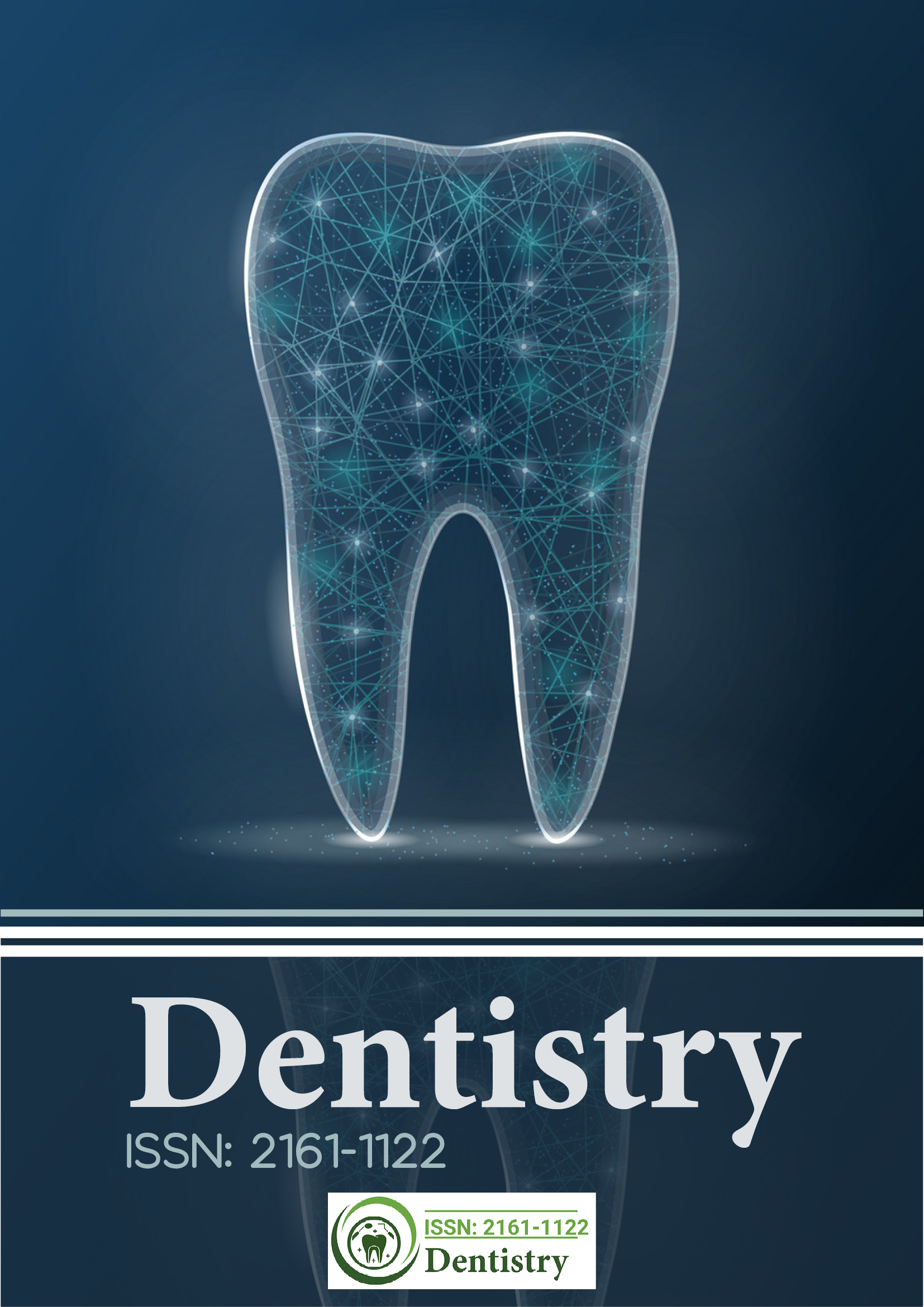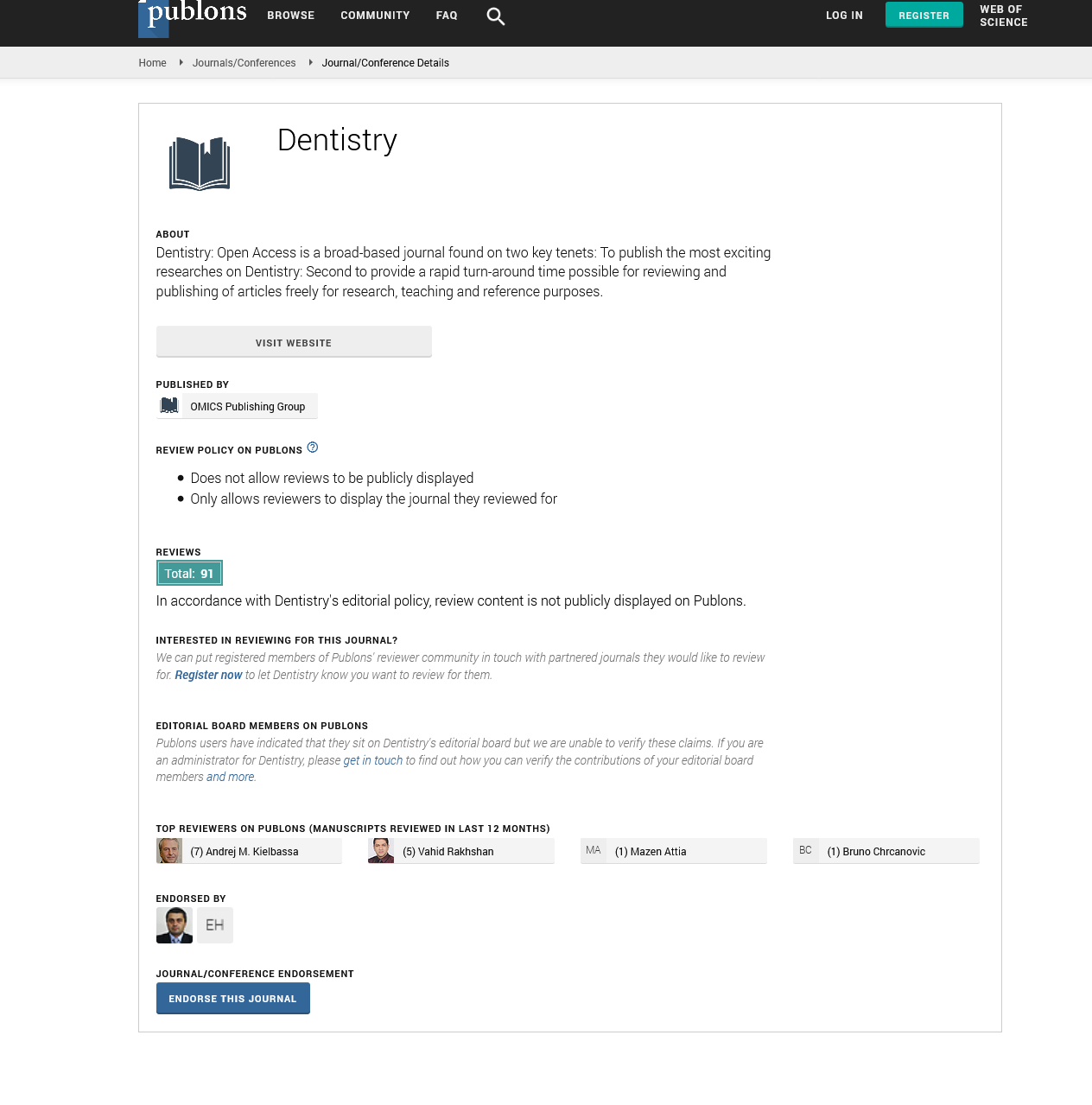Citations : 2345
Dentistry received 2345 citations as per Google Scholar report
Indexed In
- Genamics JournalSeek
- JournalTOCs
- CiteFactor
- Ulrich's Periodicals Directory
- RefSeek
- Hamdard University
- EBSCO A-Z
- Directory of Abstract Indexing for Journals
- OCLC- WorldCat
- Publons
- Geneva Foundation for Medical Education and Research
- Euro Pub
- Google Scholar
Useful Links
Share This Page
Journal Flyer

Open Access Journals
- Agri and Aquaculture
- Biochemistry
- Bioinformatics & Systems Biology
- Business & Management
- Chemistry
- Clinical Sciences
- Engineering
- Food & Nutrition
- General Science
- Genetics & Molecular Biology
- Immunology & Microbiology
- Medical Sciences
- Neuroscience & Psychology
- Nursing & Health Care
- Pharmaceutical Sciences
Opinion - (2025) Volume 15, Issue 2
Water Mediated Changes in Dental Restorative Materials
Antonio Carrillo*Received: 26-May-2025, Manuscript No. DCR-25-29705; Editor assigned: 28-May-2025, Pre QC No. DCR-25-29705 (PQ); Reviewed: 11-Jun-2025, QC No. DCR-25-29705; Revised: 18-Jun-2025, Manuscript No. DCR-25-29705 (R); Published: 25-Jun-2025, DOI: 10.35248/2161-1122.25.15.731
Description
Dental resin composites are widely used in restorative dentistry due to their esthetic qualities and mechanical performance. One of the main challenges with resin composites is polymerization shrinkage, which induces contraction stress at the tooth-restoration interface. Contraction stress may lead to marginal gaps, secondary caries and post-operative sensitivity. Water sorption by resin composites can contribute to stress relaxation over time, reducing interfacial stress and improving restoration longevity. This review examines the mechanisms of contraction stress, the influence of water sorption and factors affecting stress release in resin composites. Material composition, filler content and clinical implications are discussed.
Resin composites consist of an organic polymer matrix, inorganic fillers and coupling agents that bind fillers to the matrix. During polymerization, monomers convert to a crosslinked polymer network, causing volumetric shrinkage. This shrinkage generates contraction stress, which can compromise restoration integrity. Water sorption is a natural process in the oral environment, where hydrophilic resin components absorb water. Water uptake can induce hygroscopic expansion, counteracting shrinkage stress. Understanding how water sorption affects contraction stress is important for predicting composite performance and improving clinical outcomes.
Mechanisms of contraction stress
Polymerization shrinkage results from monomer conversion to polymer and network formation. As the resin polymerizes, the material volume decreases, creating stress at bonded interfaces. The magnitude of contraction stress depends on polymerization rate, filler content, cavity geometry and bonding strength. High-viscosity composites or bulk-fill materials may develop greater stress during polymerization due to restricted flow. Contraction stress can compromise marginal seal, promote microleakage and contribute to restoration failure.
Water sorption and hygroscopic expansion
Water sorption occurs when hydrophilic components of the resin matrix absorb oral fluids. The absorbed water causes swelling of the polymer network, resulting in hygroscopic expansion. This expansion can partially offset polymerization shrinkage and reduce contraction stress at the tooth-restoration interface. Water sorption is influenced by monomer hydrophilicity, filler content and degree of conversion. Composites with higher filler loading generally absorb less water due to reduced resin volume, while more hydrophilic matrices take up more water and exhibit greater stress release.
Factors affecting stress release
Several factors influence the extent to which water sorption reduces contraction stress. Resin composition, filler particle size and distribution affect both shrinkage and water uptake. Silane coupling agents enhance filler-matrix bonding and may limit excessive swelling, ensuring controlled stress relaxation. Environmental conditions, such as temperature and humidity, also modulate water absorption and expansion. Composite curing protocols, including light intensity, exposure time and incremental layering, affect polymerization shrinkage and the subsequent potential for stress release by water sorption.
Experimental evidence
Studies have demonstrated that water sorption can reduce contraction stress in dental resin composites. Laboratory tests using bonded composite specimens show that hygroscopic expansion occurs within days to weeks after polymerization. The degree of stress reduction depends on composite formulation, filler type and resin matrix properties. Composites with higher hydrophilicity or lower filler loading exhibit more pronounced stress relaxation. Rheological and mechanical analyses confirm that water sorption induces dimensional changes sufficient to partially offset polymerization shrinkage, improving interfacial stability.
Polymerization contraction stress is a critical factor influencing the performance of dental resin composites. Water sorption induces hygroscopic expansion that can partially relieve this stress, improve interfacial adaptation and reduce the risk of microleakage. Resin composition, filler content and silane coupling agents modulate both contraction stress and water uptake, affecting the extent of stress release. Understanding these interactions allows clinicians to optimize material selection, curing protocols and placement techniques. Future developments in composite design will enhance the balance between stress management, mechanical strength and long-term durability in restorative dentistry.
Citation: Carrillo A (2025). Water Mediated Changes in Dental Restorative Materials. J Dentistry. 15:731.
Copyright: © 2025 Carrillo A. This is an open-access article distributed under the terms of the Creative Commons Attribution License, which permits unrestricted use, distribution, and reproduction in any medium, provided the original author and source are credited.

